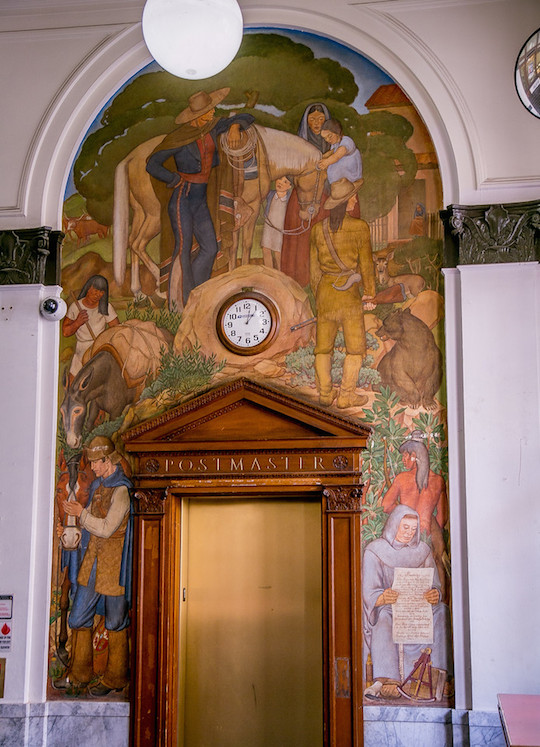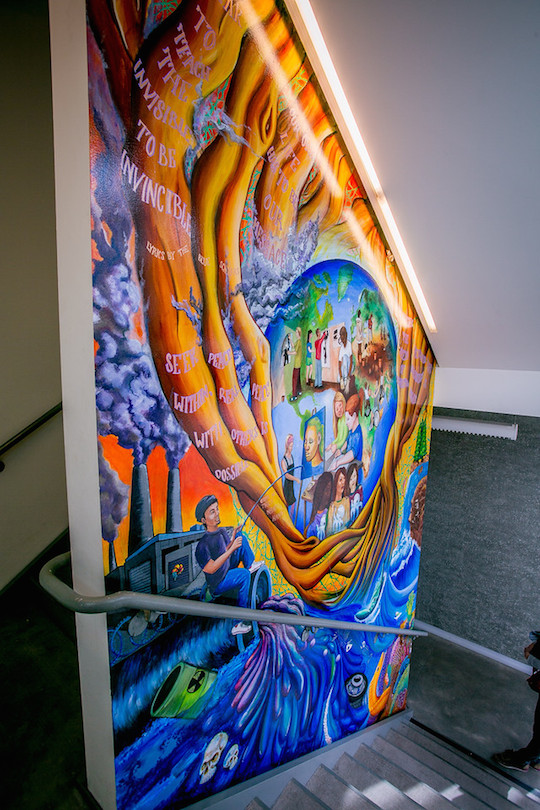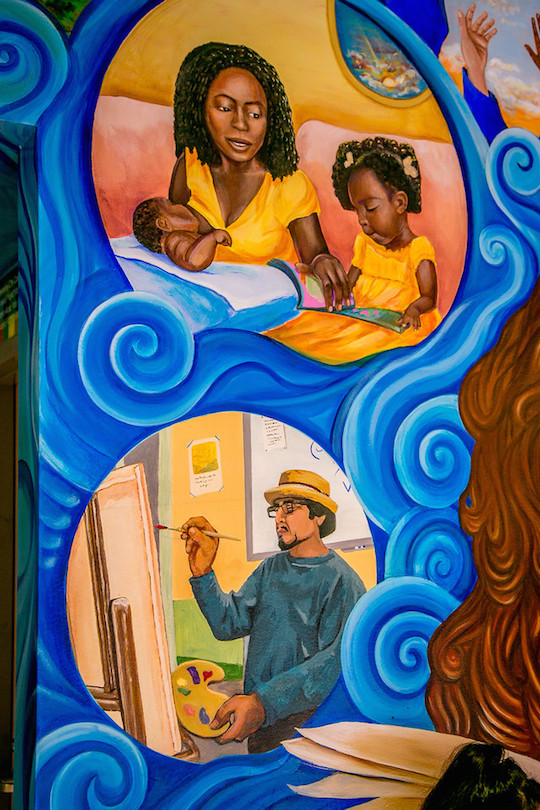Murals come and murals go. Some are still here, but we wouldn’t know it if we were not paying close attention. I have elsewhere included photos of three that fit into this category of not gone but forgotten (or not easily seen).
First, Jane Norling‘s mural celebrating the Sandinista literacy campaign in Nicaragua.
You have to stand on your toes and look over the gate towards the south to see it. Jane Norling painted this mural in 1984 in Balmy Alley, San Francisco. When the landlord who owned the fenced property took the fence down, Jane brought it plank by plank to Berkeley where it lives, largely hidden.
The second hidden that I have included elsewhere is the garage at 1187 Arch Street. For several years, the garage existed only as a shell. The owner commissioned Far and Few, an art collective, to paint the walls of the shell.
But then, in 2014, the owner finished off the garage, hiding this wonderful mural behind garage doors. Not seen, but not forgotten.
Third – the hidden remains of the University Avenue Co-Op mural “Winds of Change.”
The Consumers Cooperative of Berkeley, which we knew simply as the Co-Op, was a bright chapter in our history. It operated from 1939 until 1988. In its prime, it was the largest cooperative of its kind in the United States or Canada. The University Avenue store was opened in 1937 by the Berkeley Buyers’ Club, an organization founded by members of the Upton Sinclair-inspired End Poverty in California (EPIC).
The Co-Op tanked in 1988 on account of (a) money problems and (b) internal governance disputes, which is another way of saying “the sad but true infighting that destroys so many organizations on the Left.”
The mural – back to the mural – was originally 16 feet high and 135 feet long. O’Brien Thiele and Daniel Galvez worked with Osha Newman on the mural. Newman describes the creation of the mural: “When I designed the People’s Park mural at Haste and Telegraph, I was living on unemployment insurance. We put a can out on the street and collected donations to pay for supplies and lunch. It was all volunteer labor. Then I won a competition for a mural on the back of the Co-op Credit Union at University Avenue.”
The Gazette of December 1, 1977, reported the grand opening of the mural, featuring music, a performance by members of the Commonarts, and short speeches. We learn in the Gazette that it took two months to paint. It is said to depict “the victory of People’s spirit over the social forces that oppose it.”
Today you walk back into a courtyard at University Avenue Cooperative Housing, 1450 University Avenue. On the east-facing walls are segments of the “Winds of Change” mural, fading, but still inspiring:



 Speaking of Osha Neumann, there is a remnant of his work in the meeting room of the University Lutheran Chapel, 2425 College Avenue. In the 1970s, the room was the home of Emergency Food Project. The Gazette of July 23, 1977, reports: “It covers all four walls of the dining area with a continuous panorama, moving from surrealistic space scenes to sections which are decorative while carrying a political message.”
Speaking of Osha Neumann, there is a remnant of his work in the meeting room of the University Lutheran Chapel, 2425 College Avenue. In the 1970s, the room was the home of Emergency Food Project. The Gazette of July 23, 1977, reports: “It covers all four walls of the dining area with a continuous panorama, moving from surrealistic space scenes to sections which are decorative while carrying a political message.”
According to the Gazette, the mural took three months to paint and was underwritten by a CETA grant. Newmann is quoted as saying “People who come to the Emergency Food Project deserve to eat in as beautiful an environment as this who can afford fancy restaurants.” The Gazette concludes with the sad but obvious – it is “a mural many people will never see.”
Pastor Jeff Johnson of the Chapel wrote Eduardo Pineda and me explaining that much of the mural was removed when the church remodeled the meeting room in the early 2000s. Pastor Jeff sent along photos of the mural before removal. Eduardo pieced the photos together to create this image:
Pastor Jeff explains: “As you can see from reviewing the entire mural on the slide, it is the story of creation from the garden, through the fall (capitalist excess, homelessness, etc.), to the restoration. I think that the restoration photo has been lost.”
The Lutheran Chapel staff told us (not royal we) that she thought that large parts of the mural had been taken to the Trinity Methodist Church at 2362 Bancroft and placed in the meeting room / breakfast program room.
I checked it out. Holy mackerel! She was right. There it is:
Wow. What a mural.
Not far from the Lutheran Chapel and Trinity Methodist are the original offices of the Center for Independent Living. It opened in 1972, guided by a philosophy of disability that holds:
- Those who know best the needs of disabled people and how to meet those needs are the disabled people themselves.
- The needs of the disabled can be met most effectively by comprehensive programs which provide a variety of services.
- Disabled people should be integrated fully into their community.
Today the focus of disability activism has shifted to the Ed Roberts Campus, but the CIL office on Telegraph remains. On a retaining wall on the south end of the parking lot is a mural, eight feet high, 75 feet long, painted in 1977. I had never seen it and thank Ted Friedman for calling it to my attention. The mural is faded but no less powerful for the fading.
Berkeleyside teaches us: “It depicts many of the founders of the disability movement, including Michael Williams, the “grandmaster” of Augmented Communications; Don Galloway, who was the head of CIL’s Research and Development department; Ann Hiserman, an early resident of the Cowell Residence Program, a precursor to UC Berkeley’s Physically Disabled Students Program; Brad Lomax, of CIL’s transportation department; Dale Dahl, who started CIL ‘s deaf services; and Nancy D’Angelo, an early attendant referral for CIL.”
Ted has reported that the mural was originally painted by Ed Monroe. In their 1980 A Survey of East Bay Murals of the 1970s, Tim Drescher and Ruth Goldman write: “This mural was painted by one of Laney College’s mural workshops, led by Gary Graham. The mural was spontaneously painted with the ideas of the Center for Independent Living. It was painted with help from the members of the Center.” I am working on reconciling the two claims, but here are the photos:
Berkeleyside published this composite of the mural, taken by Panoramic Interests:
The mural is front and center in a Landmark vs. Development controversy now, with the Center and Monroe arguing that the mural can be rerouted at the Roberts campus. Stay tuned. Go see it now.
Speaking of controversy – with all the politics around the sale of the downtown post office, we just don’t talk enough about the WPA mural surrounding the elevator at the west end of the lobby.
Suzanne Scheuer painted the mural for the Treasury Relief Art Project between 1936 and 1937. She also painted the “Newsgathering” mural at Coit Tower, the “Indians Moving” mural at the Burleson County Courthouse in Caldwell, Texas, and the “Peace Activities of the Army” at the Presidio in San Francisco. The Berkeley Post Office mural, “Incidents in California,” depicts the earliest inhabitants of Berkeley.
South a block is the Berkeley Community College. For its 40th anniversary, BCC installed a mural in its atrium, “From the Ground Up/ Desde las Raices.” It was directed by Tirso Araiza, designed by True Colors Mural Project students with Eduardo Pineda, and painted by Juana Alicia, Rob Gibson, Miguel-Angel Mondragon-Ayala Bounce-Perez, Nadya Voynovskaya and community volunteers.
There are several other murals at BCC that I missed. Dang. Will return and photograph them.
Another block north and a little west is the YMCA-PG&E Teen Center. In 2011, the mural was created by Berkeley City College students, directed by Juana Alicia.”Collective Consciousness” is a three-story mural that is illuminated on the interior stairway facing Martin Luther King Jr. Way.
One of the oldest murals in Berkeley is rarely seen. It is found at the Berkeley Piano Club, 2724-2726 Haste. The club is what it sounds like, and is still active. Internationally known pianists have performed here, as have aspiring pianists.
This clipping from the Gazette tells us that the mural was painted for a 1923 Russian musical. In The Berkeley Piano Club, Mary Commanday elaborates:
The brightly painted mural over the fireplace today was painted by Mrs. Richardson and her daughters, Jane Richardson and Florence Richardson Wycoff, the original on paper as a poster for the show. By 1938, this was beginning to show wear and fade, so the Board asked Maude Richardson’s daughter Florence to replace it with a permanent one painted in oils on linen. This is the mural, with its colorful Russian folk themes, still covering the entire east wall over and around the fireplace.
The idea of a piano club is quirky. The mural is stunning. I intend to find out more about the mural.
Last, for now at least, are photos of several murals at the Indus Village restaurant on San Pablo just south of University. Restaurant murals are not exactly hidden, but we might not think of them when we mentally catalog murals in Berkeley. The Turkish Kitchen on Shattuck had a great floor and ceiling mural, now painted over. Caffee Venezia on University had a great floor to ceiling tromp l’oeil mural but the restaurant closed in 2013.
The murals at Indus Village are stunning:
Good job Indus!
I showed these photos to my friend. He was leafing through a stack of photos of right-wing, anti-Semitic murals from Ohio. He noted, fairly enough, that most murals with a political message are left-leaning. “Why is that, do you think?” I said I’d be happy to have a longer conversation about the politics of art, but for right now could I get his take on these hidden murals? Of course:

















































